(完整word版)中考英语每日一题之动词词义辨析-borrow和lend
- 格式:doc
- 大小:12.87 KB
- 文档页数:1
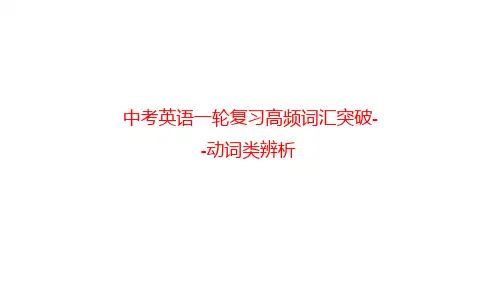
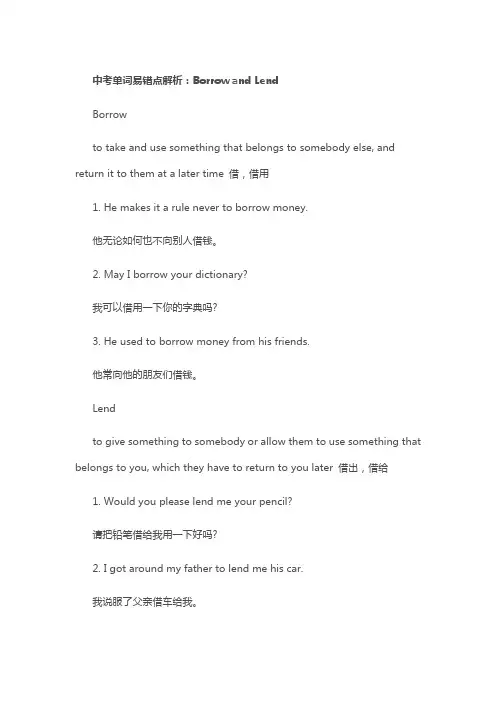
中考单词易错点解析:Borrow and LendBorrowto take and use something that belongs to somebody else, and return it to them at a later time 借,借用1. He makes it a rule never to borrow money.他无论如何也不向别人借钱。
2. May I borrow your dictionary?我可以借用一下你的字典吗?3. He used to borrow money from his friends.他常向他的朋友们借钱。
Lendto give something to somebody or allow them to use something that belongs to you, which they have to return to you later 借出,借给1. Would you please lend me your pencil?请把铅笔借给我用一下好吗?2. I got around my father to lend me his car.我说服了父亲借车给我。
3. It was imprudent of you to lend money to a stranger.你把钱借给陌生人,未免太轻率了。
【注意】1. borrow和lend都可以表示”借”,但是使用场合不同。
borrow指”借入”,而lend指”借出”。
(1)May I borrow this book for a day or two? (对主语而言是借入)(2)Would you lend me this book for a day or two?(对主语而言是借出)2. 请注意borrow和lend介词搭配的不同。
(1)I don’t like to borrow money from friends.(2)He lent his pen to me.中考单词易错点解析:Compete and CompleteCompeteto try to be more successful or better than somebody else who is trying to do the same as you 竞争,比赛,对抗[不及物动词]1. We can’t compete with them on price.我们在价格上无法与他们竞争。
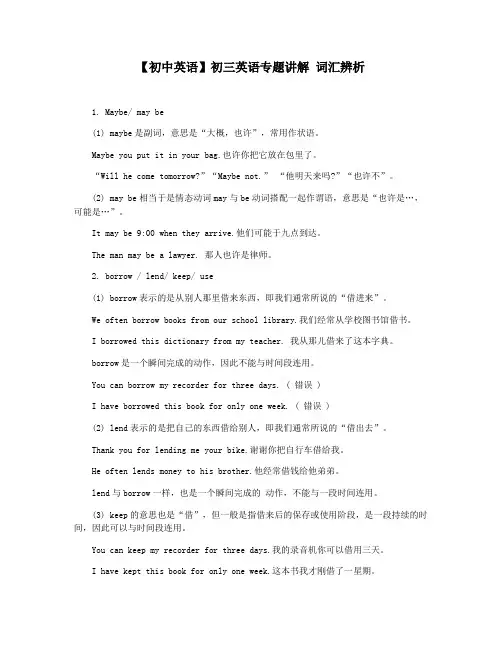
【初中英语】初三英语专题讲解词汇辨析1. Maybe/ may be(1) maybe是副词,意思是“大概,也许”,常用作状语。
Maybe you put it in your bag.也许你把它放在包里了。
“Will he come tomorrow?”“Maybe not.” “他明天来吗?”“也许不”。
(2) may be相当于是情态动词may与be动词搭配一起作谓语,意思是“也许是…,可能是…”。
It may be 9:00 when they arrive.他们可能于九点到达。
The man may be a lawyer. 那人也许是律师。
2. borrow / lend/ keep/ use(1) borrow表示的是从别人那里借来东西,即我们通常所说的“借进来”。
We often borrow books from our school library.我们经常从学校图书馆借书。
I borrowed this dictionary from my teacher. 我从那儿借来了这本字典。
borrow是一个瞬间完成的动作,因此不能与时间段连用。
You can borrow my recorder for three days. ( 错误 )I have borrowed this book for only one week. ( 错误 )(2) lend表示的是把自己的东西借给别人,即我们通常所说的“借出去”。
Thank you for lending me your bike.谢谢你把自行车借给我。
He often lends money to his brother.他经常借钱给他弟弟。
lend与borrow一样,也是一个瞬间完成的动作,不能与一段时间连用。
(3) keep的意思也是“借”,但一般是指借来后的保存或使用阶段,是一段持续的时间,因此可以与时间段连用。
You can keep my recorder for three days.我的录音机你可以借用三天。
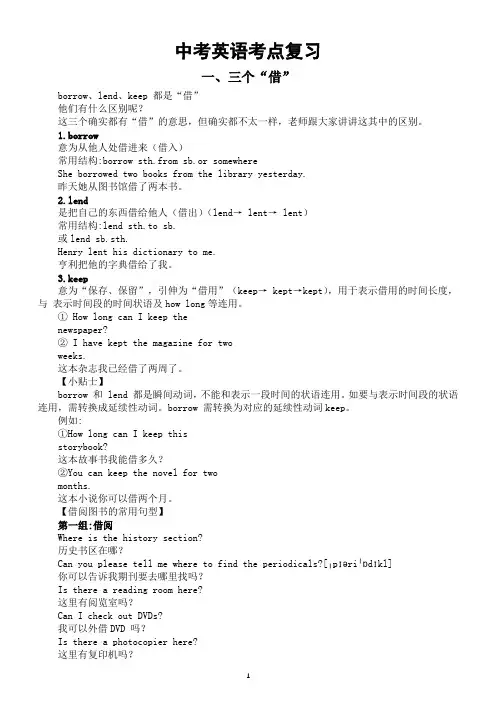
中考英语考点复习一、三个“借”borrow、lend、keep 都是“借”他们有什么区别呢?这三个确实都有“借”的意思,但确实都不太一样,老师跟大家讲讲这其中的区别。
1.borrow意为从他人处借进来(借入)常用结构:borrow sth.from sb.or somewhereShe borrowed two books from the library yesterday.昨天她从图书馆借了两本书。
2.lend是把自己的东西借给他人(借出)(lend→ lent→ lent)常用结构:lend sth.to sb.或lend sb.sth.Henry lent his dictionary to me.亨利把他的字典借给了我。
3.keep意为“保存、保留”,引伸为“借用”(keep→ kept→kept),用于表示借用的时间长度,与表示时间段的时间状语及how long等连用。
① How long can I keep thenewspaper?② I have kept the magazine for twoweeks.这本杂志我已经借了两周了。
【小贴士】borrow 和 lend 都是瞬间动词,不能和表示一段时间的状语连用。
如要与表示时间段的状语连用,需转换成延续性动词。
borrow 需转换为对应的延续性动词keep。
例如:①How long can I keep thisstorybook?这本故事书我能借多久?②You can keep the novel for twomonths.这本小说你可以借两个月。
【借阅图书的常用句型】第一组:借阅Where is the history section?历史书区在哪?Can you please tell me where to find the periodicals?[ˌpɪəriˈɒdɪkl]你可以告诉我期刊要去哪里找吗?Is there a reading room here?这里有阅览室吗?Can I check out DVDs?我可以外借DVD 吗?Is there a photocopier here?这里有复印机吗?How much does it cost to use the photocopier?[ˈfəʊtəʊkɒpiə(r)] 要付多少钱才能使用复印机?第二组:找书Can you reserve this book for me?你可以帮我预订这本书吗?Can you request this book fromanother library for me?你可以帮我从另一家图书馆调这本书吗?Can you tell me where I can find the Old Man and the Sea?你可以告诉我要去哪找《老人与海》这本书吗?I want to borrow two books onEnglish grammar ; can you showme where I can find them?我想借两本有关英语语法的书,你能告诉我在哪里可以找到吗?第三组:提供帮助Can I help you? What kind ofbooks are you looking for?需要帮助吗,您在找哪类书呢?Here are the books you need.这是您要的书。
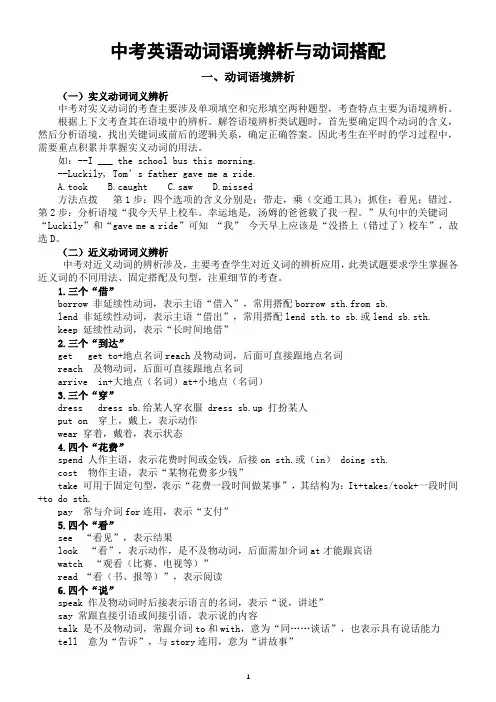
中考英语动词语境辨析与动词搭配一、动词语境辨析(一)实义动词词义辨析中考对实义动词的考查主要涉及单项填空和完形填空两种题型,考查特点主要为语境辨析。
根据上下文考查其在语境中的辨析。
解答语境辨析类试题时,首先要确定四个动词的含义,然后分析语境,找出关键词或前后的逻辑关系,确定正确答案。
因此考生在平时的学习过程中,需要重点积累并掌握实义动词的用法。
如:--I ___ the school bus this morning.--Luckily, Tom’s father gave me a ride.A.tookB.caughtC.sawD.missed方法点拨第1步:四个选项的含义分别是:带走,乘(交通工具);抓住;看见;错过。
第2步:分析语境“我今天早上校车。
幸运地是, 汤姆的爸爸载了我一程。
”从句中的关键词“Luckily”和“gave me a ride”可知“我” 今天早上应该是“没搭上(错过了)校车”,故选D。
(二)近义动词词义辨析中考对近义动词的辨析涉及,主要考查学生对近义词的辨析应用,此类试题要求学生掌握各近义词的不同用法、固定搭配及句型,注重细节的考查。
1.三个“借”borrow 非延续性动词,表示主语“借入”,常用搭配borrow sth.from sb.lend 非延续性动词,表示主语“借出”,常用搭配lend sth.to sb.或lend sb.sth.keep 延续性动词,表示“长时间地借”2.三个“到达”get get to+地点名词reach及物动词,后面可直接跟地点名词reach 及物动词,后面可直接跟地点名词arrive in+大地点(名词)at+小地点(名词)3.三个“穿”dress dress sb.给某人穿衣服 dress sb.up 打扮某人put on 穿上,戴上,表示动作wear 穿着,戴着,表示状态4.四个“花费”spend 人作主语,表示花费时间或金钱,后接on sth.或(in) doing sth.cost 物作主语,表示“某物花费多少钱”take 可用于固定句型,表示“花费一段时间做某事”,其结构为:It+takes/took+一段时间+to do sth.pay 常与介词for连用,表示“支付”5.四个“看”see “看见”,表示结果look “看”,表示动作,是不及物动词,后面需加介词at才能跟宾语watch “观看(比赛、电视等)”read “看(书、报等)”,表示阅读6.四个“说”speak 作及物动词时后接表示语言的名词,表示“说,讲述”say 常跟直接引语或间接引语,表示说的内容talk 是不及物动词,常跟介词to和with,意为“同……谈话”,也表示具有说话能力tell 意为“告诉”,与story连用,意为“讲故事”7.四个“拿”bring “带来,拿来”,表示拿到靠近说话人的地方take “拿去,带走”,表示拿到远离说话人的地方carry “扛,搬,用力移动”,没有方向fetch “去取,去拿”,表示往返拿东西8.四个“赢,输”lose 意为“输给”某人,固定搭配为lose to sb.fail 意为“失败”或“未做成某事”beat 意为“打败”,后接人或某支队伍win 意为“赢得,荣誉,地位,比赛等”9.四个“参加”join 一般指加入“党派”或“组织”并成为其中一员,如参军,入党,入团等join in 指参加竞赛、娱乐、游戏等活动take part in 指参加聚会或群众性活动attend 一般指出席会议、典礼、婚礼等10.四个“变化”turn 一般用于颜色的变化get 天变黑、变长或变短become 天气变暖或变冷等,表示渐变grow 形状变大或变小(三)感官动词词义辨析sound 意为“听起来……”指听觉。
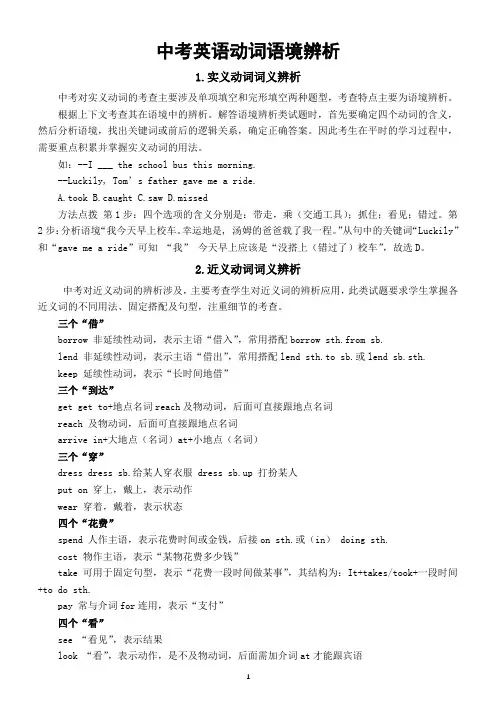
中考英语动词语境辨析1.实义动词词义辨析中考对实义动词的考查主要涉及单项填空和完形填空两种题型,考查特点主要为语境辨析。
根据上下文考查其在语境中的辨析。
解答语境辨析类试题时,首先要确定四个动词的含义,然后分析语境,找出关键词或前后的逻辑关系,确定正确答案。
因此考生在平时的学习过程中,需要重点积累并掌握实义动词的用法。
如:--I ___ the school bus this morning.--Luckily, Tom’s father gave me a ride.A.tookB.caughtC.sawD.missed方法点拨第1步:四个选项的含义分别是:带走,乘(交通工具);抓住;看见;错过。
第2步:分析语境“我今天早上校车。
幸运地是, 汤姆的爸爸载了我一程。
”从句中的关键词“Luckily”和“gave me a ride”可知“我”今天早上应该是“没搭上(错过了)校车”,故选D。
2.近义动词词义辨析中考对近义动词的辨析涉及,主要考查学生对近义词的辨析应用,此类试题要求学生掌握各近义词的不同用法、固定搭配及句型,注重细节的考查。
三个“借”borrow 非延续性动词,表示主语“借入”,常用搭配borrow sth.from sb.lend 非延续性动词,表示主语“借出”,常用搭配lend sth.to sb.或lend sb.sth.keep 延续性动词,表示“长时间地借”三个“到达”get get to+地点名词reach及物动词,后面可直接跟地点名词reach 及物动词,后面可直接跟地点名词arrive in+大地点(名词)at+小地点(名词)三个“穿”dress dress sb.给某人穿衣服 dress sb.up 打扮某人put on 穿上,戴上,表示动作wear 穿着,戴着,表示状态四个“花费”spend 人作主语,表示花费时间或金钱,后接on sth.或(in) doing sth.cost 物作主语,表示“某物花费多少钱”take 可用于固定句型,表示“花费一段时间做某事”,其结构为:It+takes/took+一段时间+to do sth.pay 常与介词for连用,表示“支付”四个“看”see “看见”,表示结果look “看”,表示动作,是不及物动词,后面需加介词at才能跟宾语watch “观看(比赛、电视等)”read “看(书、报等)”,表示阅读四个“说”speak 作及物动词时后接表示语言的名词,表示“说,讲述”say 常跟直接引语或间接引语,表示说的内容talk 是不及物动词,常跟介词to和with,意为“同……谈话”,也表示具有说话能力tell 意为“告诉”,与story连用,意为“讲故事”四个“拿”bring “带来,拿来”,表示拿到靠近说话人的地方take “拿去,带走”,表示拿到远离说话人的地方carry “扛,搬,用力移动”,没有方向fetch “去取,去拿”,表示往返拿东西四个“赢,输”lose 意为“输给”某人,固定搭配为lose to sb.fail 意为“失败”或“未做成某事”beat 意为“打败”,后接人或某支队伍win 意为“赢得,荣誉,地位,比赛等”四个“参加”join 一般指加入“党派”或“组织”并成为其中一员,如参军,入党,入团等join in 指参加竞赛、娱乐、游戏等活动take part in 指参加聚会或群众性活动attend 一般指出席会议、典礼、婚礼等四个“变化”turn 一般用于颜色的变化get 天变黑、变长或变短become 天气变暖或变冷等,表示渐变grow 形状变大或变小3.感官动词词义辨析sound 意为“听起来……”指听觉。

lend borrow的用法Title: Understanding the Usage of 'Lend' and 'Borrow'Introduction:'Lend' and 'borrow' are two commonly used verbs when talking about borrowing and lending something to someone. However, their usage can often be confusing for non-native English speakers. In this article, we will delve into the definitions, differences, and correct usage of 'lend' and 'borrow' in various contexts.I. Definitions:1. 'Lend':'Lend' means to temporarily give something to someone with the expectation of receiving it back in the future. The lender is the person who 'lends' the item.Example: I will lend you my bicycle for the weekend.2. 'Borrow':'Borrow' means to temporarily take or receive something from someone with the intent to return it later. The borrower is the person who 'borrows' the item.Example: Can I borrow your pen for a moment?II. Correct Usage:1. 'Lend':- The subject is the lender, and the object is the thing being lent. - The verb 'lend' is used for giving.Example: Susan will lend her car to John for the weekend.2. 'Borrow':- The subject is the borrower, and the object is the thing being borrowed.- The verb 'borrow' is used for receiving.Example: John will borrow Susan's car for the weekend.III. Proper Sentence Structures:1. Active Voice:- The lender comes first, followed by the receiver.Example: David lent his camera to Emily last week.2. Passive Voice:- The receiver comes first, followed by the lender.Example: Emily was lent David's camera last week.IV. Additional Usage Patterns:1. 'Lend' and 'Borrow' with Prepositions:- It is common to use prepositions when talking about 'lending' or 'borrowing' money. In such cases, 'to' is used with 'lend,' and 'from' is used with 'borrow.'Example: Jane will lend 100 to Peter. (Jane is giving money to Peter.) Peter will borrow 100 from Jane. (Peter is receiving money from Jane.)2. 'Lend' in the Continuous Tenses:- Although rare, 'lend' can be used in continuous or progressive tenses.Example: Sarah is lending a helping hand to her neighbor.3. 'Borrow' in the Continuous Tenses:- Unlike 'lend,' 'borrow' is not used in continuous tenses. Example: Incorrect: Michael is borrowing his friend's car for the weekend.Correct: Michael borrowed his friend's car for the weekend.V. Common Mistakes:1. Mistaking 'lend' for 'borrow' or vice versa:- It is essential to use the correct verb depending on whether you are the giver or the receiver.Example: Incorrect: Can you lend me your textbook?Correct: Can you borrow me your textbook?2. Mistakenly using 'to' with 'lend' instead of 'from':- It is crucial to use the correct preposition when talking about money transactions.Example: Incorrect: John will lend 50 from me.Correct: John will borrow 50 from me.Conclusion:Understanding the proper usage and distinctions between 'lend' and 'borrow' is essential for effective communication in English. By using this guide, you can confidently use these verbs in the appropriate context, avoiding common mistakes and improving your overall language proficiency.。
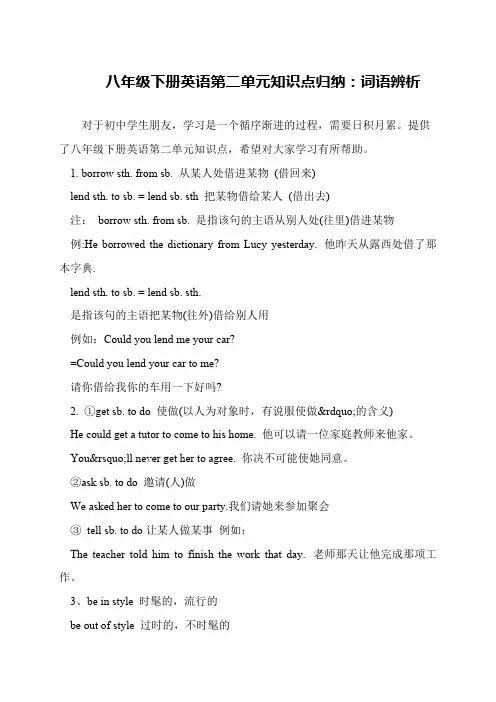
八年级下册英语第二单元知识点归纳:词语辨析对于初中学生朋友,学习是一个循序渐进的过程,需要日积月累。
提供了八年级下册英语第二单元知识点,希望对大家学习有所帮助。
1. borrow sth. from sb. 从某人处借进某物(借回来) lend sth. to sb. = lend sb. sth 把某物借给某人(借出去) 注:borrow sth. from sb. 是指该句的主语从别人处(往里)借进某物 例:He borrowed the dictionary from Lucy yesterday. 他昨天从露西处借了那本字典. lend sth. to sb. = lend sb. sth. 是指该句的主语把某物(往外)借给别人用 例如:Could you lend me your car? =Could you lend your car to me? 请你借给我你的车用一下好吗? 2. ①get sb. to do 使做(以人为对象时,有说服使做”的含义) He could get a tutor to come to his home. 他可以请一位家庭教师来他家。
You’ll never get her to agree. 你决不可能使她同意。
②ask sb. to do 邀请(人)做 We asked her to come to our party.我们请她来参加聚会 ③tell sb. to do让某人做某事例如: The teacher told him to finish the work that day. 老师那天让他完成那项工作。
3、be in style 时髦的,流行的 be out of style 过时的,不时髦的。
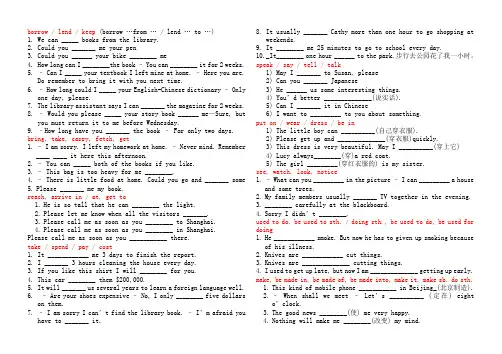
矿产资源开发利用方案编写内容要求及审查大纲
矿产资源开发利用方案编写内容要求及《矿产资源开发利用方案》审查大纲一、概述
㈠矿区位置、隶属关系和企业性质。
如为改扩建矿山, 应说明矿山现状、
特点及存在的主要问题。
㈡编制依据
(1简述项目前期工作进展情况及与有关方面对项目的意向性协议情况。
(2 列出开发利用方案编制所依据的主要基础性资料的名称。
如经储量管理部门认定的矿区地质勘探报告、选矿试验报告、加工利用试验报告、工程地质初评资料、矿区水文资料和供水资料等。
对改、扩建矿山应有生产实际资料, 如矿山总平面现状图、矿床开拓系统图、采场现状图和主要采选设备清单等。
二、矿产品需求现状和预测
㈠该矿产在国内需求情况和市场供应情况
1、矿产品现状及加工利用趋向。
2、国内近、远期的需求量及主要销向预测。
㈡产品价格分析
1、国内矿产品价格现状。
2、矿产品价格稳定性及变化趋势。
三、矿产资源概况
㈠矿区总体概况
1、矿区总体规划情况。
2、矿区矿产资源概况。
3、该设计与矿区总体开发的关系。
㈡该设计项目的资源概况
1、矿床地质及构造特征。
2、矿床开采技术条件及水文地质条件。
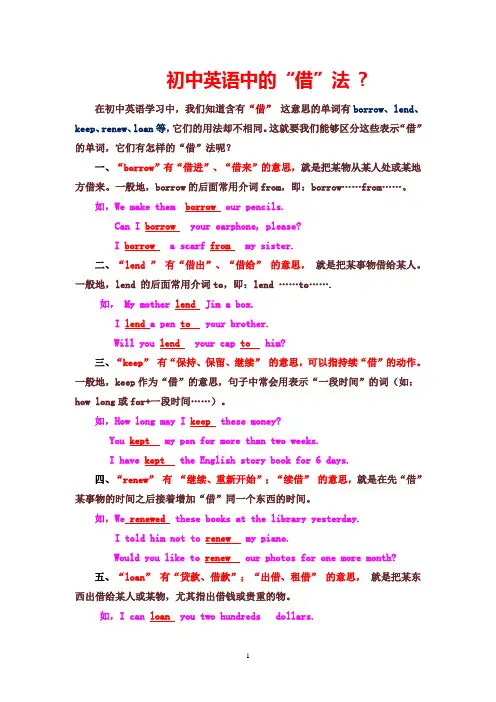
初中英语中的“借”法?在初中英语学习中,我们知道含有“借”这意思的单词有borrow、lend、keep、renew、loan等,它们的用法却不相同。
这就要我们能够区分这些表示“借”的单词,它们有怎样的“借”法呢?一、“borrow”有“借进”、“借来”的意思,就是把某物从某人处或某地方借来。
一般地,borrow的后面常用介词from,即:borrow……from……。
如,We make them borrow our pencils.Can I borrow your earphone, please?I borrow a scarf from my sister.二、“lend ”有“借出”、“借给”的意思,就是把某事物借给某人。
一般地,lend 的后面常用介词to,即:lend ……to…….如, My mother lend Jim a box.I lend a pen to your brother.Will you lend your cap to him?三、“keep”有“保持、保留、继续”的意思,可以指持续“借”的动作。
一般地,keep作为“借”的意思,句子中常会用表示“一段时间”的词(如:how long或for+一段时间……)。
如,How long may I keep these money?You kept my pen for more than two weeks.I have kept the English story book for 6 days.四、“renew”有“继续、重新开始”;“续借”的意思,就是在先“借”某事物的时间之后接着增加“借”同一个东西的时间。
如,We renewed these books at the library yesterday.I told him not to renew my piano.Would you like to renew our photos for one more month?五、“loan”有“贷款、借款”;“出借、租借”的意思,就是把某东西出借给某人或某物,尤其指出借钱或贵重的物。
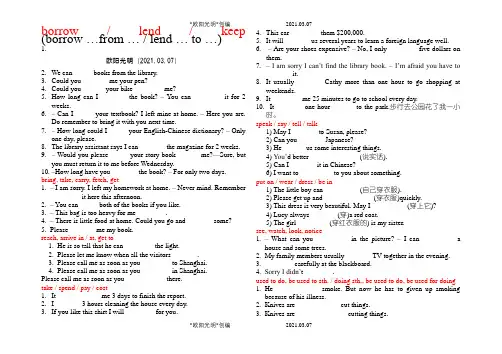
*欧阳光明*创编 2021.03.07 *欧阳光明*创编 2021.03.07 borrow / lend / keep
(borrow …from … / lend … to …)
1. 欧阳光明(2021.03.07) 2. We can _____ books from the library. 3. Could you _______ me your pen? 4. Could you ______ your bike ________ me? 5. How long can I ________the book? – You can ________ it for 2 weeks. 6. – Can I _____ your textbook? I left mine at home. – Here you are. Do remember to bring it with you next time. 7. – How long could I _____ your English-Chinese dictionary? – Only one day, please. 8. The library assistant says I can _______ the magazine for 2 weeks. 9. – Would you please _____ your story book ______ me?—Sure, but you must return it to me before Wednesday. 10. –How long have you _______ the book? – For only two days. bring, take, carry, fetch, get 1. – I am sorry. I left my homework at home. – Never mind. Remember ____ ____ it here this afternoon. 2. – You can _____ both of the books if you like. 3. – This bag is too heavy for me ________. 4. – There is little food at home. Could you go and _______ some? 5. Please _______ me my book. reach, arrive in / at, get to 1. He is so tall that he can ________ the light. 2. Please let me know when all the visitors _______. 3. Please call me as soon as you ________ to Shanghai. 4. Please call me as soon as you ________ in Shanghai. Please call me as soon as you ___________ there. take / spend / pay / cost 1. It ____________ me 3 days to finish the report. 2. I _______ 3 hours cleaning the house every day. 3. If you like this shirt I will ________ for you. 4. This car ________ them $200,000. 5. It will _______ us several years to learn a foreign language well. 6. – Are your shoes expensive? – No, I only ________ five dollars on them. 7. – I am sorry I can’t find the library book. – I’m afraid you have to _______ it. 8. It usually _______ Cathy more than one hour to go shopping at weekends. 9. It ________ me 25 minutes to go to school every day. 10. _It________ one hour ______ to the park.步行去公园花了我一小时。 speak / say / tell / talk 1) May I _______ to Susan, please? 2) Can you _______ Japanese? 3) He ______ us some interesting things. 4) You’d better ______________(说实话). 5) Can I _______ it in Chinese? 6) I want to _________ to you about something. put on / wear / dress / be in 1) The little boy can __________(自己穿衣服). 2) Please get up and ______________(穿衣服)quickly. 3) This dress is very beautiful. May I __________(穿上它)? 4) Lucy always________(穿)a red coat. 5) The girl _________(穿红衣服的) is my sister. see, watch, look, notice 1. – What can you _________ in the picture? – I can _________ a house and some trees. 2. My family members usually _______ TV together in the evening. 3. ________ carefully at the blackboard. 4. Sorry I didn’t ________. used to do, be used to sth. / doing sth., be used to do, be used for doing 1. He ____________ smoke. But now he has to given up smoking because of his illness. 2. Knives are ____________ cut things. 3. Knives are ______________ cutting things. *欧阳光明*创编 2021.03.07 *欧阳光明*创编 2021.03.07 4. I used to get up late, but now I am ______________ getting up early. make, be made in, be made of, be made into, make it, make sb. do sth. 1. This kind of mobile phone ___________ in Beijing_(北京制造). 2. – When shall we meet? – Let’s __________ (定在) eight o’clock. 3. The good news ________(使) me very happy. 4. Nothing will make me ________(改变) my mind. 5. All the windows of the building are ____________(由…制成) glass. 6. A lot of rubbish can be recycled. These old clothes can be ________________(制成) shopping bags.
borrow / lend / keep (borrow …from … / lend … to …) 1. We can _____ books from the library. 2. Could you _______ me your pen? 3. Could you ______ your bike ________ me? 4. How long can I ________the book? – You can ________ it for 2 weeks. 5. – Can I _____ your textbook? I left mine at home. – Here you are. Do remember to bring it with you next time. 6. – How long could I _____ your English-Chinese dictionary? – Only one day, please. 7. The library assistant says I can _______ the magazine for 2 weeks. 8. – Would you please _____ your story book ______ me?—Sure, but you must return it to me before Wednesday. 9. –How long have you _______ the book? – For only two days. bring, take, carry, fetch, get 1. – I am sorry. I left my homework at home. – Never mind. Remember ____ ____ it here this afternoon. 2. – You can _____ both of the books if you like. 3. – This bag is too heavy for me ________. 4. – There is little food at home. Could you go and _______ some? 5. Please _______ me my book. reach, arrive in / at, get to 1. He is so tall that he can ________ the light. 2. Please let me know when all the visitors _______. 3. Please call me as soon as you ________ to Shanghai. 4. Please call me as soon as you ________ in Shanghai. Please call me as soon as you ___________ there. take / spend / pay / cost 1. It ____________ me 3 days to finish the report. 2. I _______ 3 hours cleaning the house every day. 3. If you like this shirt I will ________ for you. 4. This car ________ them $200,000. 5. It will _______ us several years to learn a foreign language well. 6. – Are your shoes expensive? – No, I only ________ five dollars on them. 7. – I am sorry I can’t find the library book. – I’m afraid you have to _______ it. 8. It usually _______ Cathy more than one hour to go shopping at weekends. 9. It ________ me 25 minutes to go to school every day. 10. _It________ one hour ______ to the park.步行去公园花了我一小时。 speak / say / tell / talk 1) May I _______ to Susan, please? 2) Can you _______ Japanese? 3) He ______ us some interesting things. 4) You’d better ______________(说实话). 5) Can I _______ it in Chinese? 6) I want to _________ to you about something. put on / wear / dress / be in 1) The little boy can __________(自己穿衣服). 2) Please get up and ______________(穿衣服)quickly. 3) This dress is very beautiful. May I __________(穿上它)? 4) Lucy always________(穿)a red coat. 5) The girl _________(穿红衣服的) is my sister. see, watch, look, notice 1. – What can you _________ in the picture? – I can _________ a house and some trees. 2. My family members usually _______ TV together in the evening. 3. ________ carefully at the blackboard. 4. Sorry I didn’t ________. used to do, be used to sth. / doing sth., be used to do, be used for doing 1. He ____________ smoke. But now he has to given up smoking because of his illness. 2. Knives are ____________ cut things. 3. Knives are ______________ cutting things. 4. I used to get up late, but now I am ______________ getting up early. make, be made in, be made of, be made into, make it, make sb. do sth. 1. This kind of mobile phone ___________ in Beijing_(北京制造). 2. – When shall we meet? – Let’s __________ (定在) eight o’clock. 3. The good news ________(使) me very happy. 4. Nothing will make me ________(改变) my mind. 5. All the windows of the building are ____________(由…制成) glass. 6. A lot of rubbish can be recycled. These old clothes can be ________________(制成) shopping bags.
Morning, Karen, 趁着早晨的好时光来一起看看今天的每日一题:
1. -Could you please __ me your notebook, Grace?
-Certainly. Here you are. (2016烟台)
A. borrow B. to borrow C. lend D. to lend
【正确答案】:C
【试题分析】:
1. 动词词义辨析。
2. 选项分析:
四个选项都是“借”,AC是动词原形,BD是其动词不定式形式。
borrow 和lend 都表示“借”,但还是有区别的:
borrow “借入”borrow sth. from sb. (向某人借某物),
注:borrow后不可接双宾语,即borrow sb. sth.句型是错误的。
He borrowed some money from his friend.他向他的朋友借了些钱。
lend “借出”lend sth. to sb. (给某人借某物)
注:lend后可接双宾语,即lend sb. sth. He lent some money to his friend.
他借了些钱给他朋友。
3. 题干分析:
句意是“-你能给我借下你的笔记本吗?-好的,给你。”,首先情态动词后为动词
原形,所以排除BD选项;其次结合语境及句型结构可知正确答案是C。
【Karen如是说】:borrow和lend这两“借”是常见的一对反义词,borrow小气
所以要“借入”,lend大方则是“借出”,并请注意其句型结构及介词。
Ok,“借入”和“借出”你搞清楚了吗?我是Karen, 我们明天见!